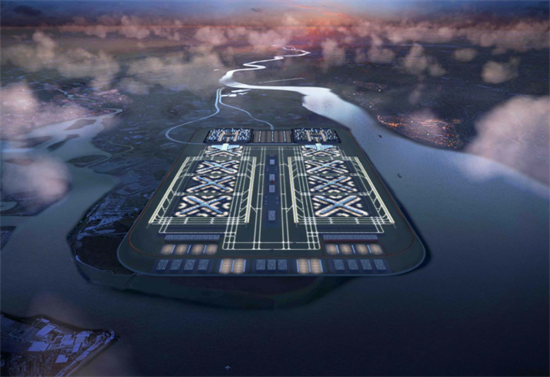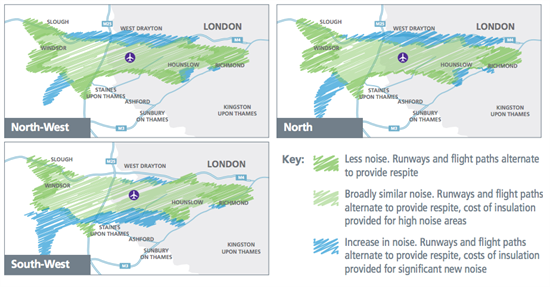Robert McSweeney
02.09.2014 | 4:48pmThe Airports Commission has dismissed Mayor of London Boris Johnson’s proposal for a new hub airport in the Thames estuary. With remaining options for expansion at either Heathrow or Gatwick what are the potential climate and environmental impacts of each?
The Airports Commission, chaired by Sir Howard Davies, recommended adding a second runway to south east England by 2030, with the possibility of another by 2050.
In December 2013, the Commission shortlisted three options for the first additional runway in its Interim Report – a second runway at Gatwick, a third runway at Heathrow or an extension to the second runway at Heathrow (so it operates like two).
Any expansion of airport capacity will lead to more flights and more passengers, and increase carbon emissions from aviation.
Proposed hub airport on the Isle of Grain in the Thames estuary. Transport for London
Carbon emissions
At the moment aviation makes up around 5 per cent of the UK’s emissions – around 33.3 megatonnes (Mt) of carbon a year in 2011. Under the Climate Change Act, the UK must reduce its carbon emissions by 80 per cent by 2050, compared with 1990 levels. That would mean we emitted no more than 160 Mt of carbon per year in 2050.
The Committee on Climate Change suggests that to stay under this limit, carbon emissions from flights will need to be no more than 37.5Mt per year. At that level aviation would use up just under a quarter of the UK’s carbon budget in 2050.
So can airports expand and stay within this level?
Research from the think tank Aviation Environment Federation suggests not. Their analysis found that a new runway – wherever it is situated – would contribute an additional 8.2 Mt of carbon emissions, making meeting the 37.5 Mt target “effectively impossible”.
The study, funded by the WWF, developed future scenarios of emissions based on aviation forecasts from the Department for Transport. It found that in order to build a new runway and still meet the 37.5 Mt target, air travel at regional airports would need to be reduced. This, the study concluded, would be “politically very difficult to implement and have significant economic consequences.”
Other environmental impacts
Heathrow has been a victim of its own success. An extra runway would make this huge airport even bigger, exacerbating local environmental challenges. The air quality around Heathrow, for example, is consistently worse than the standards required by the EU. Heathrow’s most recent proposal suggests more frequent rail links and a congestion charge to discourage passengers from using their cars.
Noise is also a significant issue. A study commissioned by the Mayor of London found that a third runway at Heathrow would increase the number of people affected by aircraft noise by over 300,000 – to over a million.
Solutions such as steeper flight paths, no-flight periods and paying for insulation are proposed to manage the problem. Failing that, the airport says it will provide compensation to those affected.
Change in patterns of air noise with additional runways at Heathrow. Heathrow Airport
Heathrow is also on Greenbelt land, but the 2003 government White Paper on Aviation had already decided that: “the benefits [of expansion] would outweigh the environmental impact as long as the effects were properly controlled.”
Gatwick would face many of the same issues as Heathrow, albeit to a lesser degree as it is a smaller airport. But it’s also located in a more rural area. A study commissioned by West Sussex County Council found that a new runway would require 30,000 to 45,000 new homes to be built in the area. Gatwick’s largest nearby town is currently Crawley, with a population of around 40,000.
Rejected options
‘Boris Island’ is the most famous of the airport expansion proposals, with the Mayor putting forward plans for a hub airport to be built in either the inner or outer Thames estuary. Its drawbacks were well documented – not least a potential cost of £120 billion and the likely impacts on important habitats in the area.
But a hub airport in the inner estuary did have some appeal to the Airport Commission, particularly for the potential to “reduce aviation noise impacts in the South East of England.”
Other options – such as expansion of Stansted or Birmingham airport – were also discounted in the Commission’s Interim Report, primarily because those airports will not be operating at capacity for many years.
With the Commission expected to make its final decision next summer, this leaves three options in two locations.
But with vocal advocates and opposition for each, it appears for the moment that the effect any new runway would have on the UK’s carbon targets has been lost amongst the noise.



